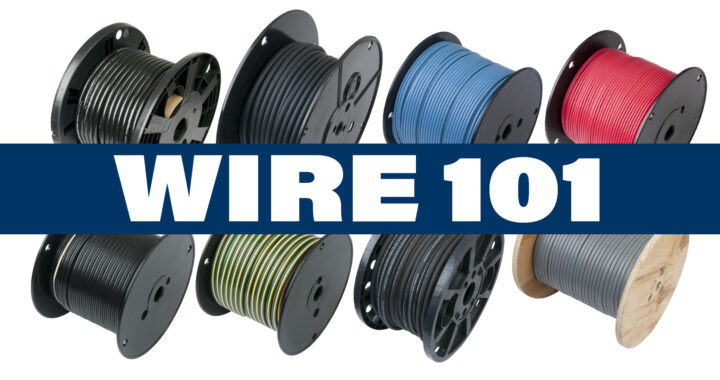When it comes to wiring, the choices can feel endless — primary wire, cross-link, marine-grade, welding cable, and more. Each type serves a specific purpose, with unique insulation, flexibility, and durability ratings. Picking the wrong wire can mean premature failure, wasted money, or even safety hazards. This guide breaks down the most common wire types, compares their features, and gives you the confidence to choose the right option for your next project.
Why Choosing the Right Wire Matters
Wire isn’t just a conductor — it’s a safety system. The right insulation can prevent shorts, withstand heat, resist oil and chemicals, and stand up to tough mechanical environments. A poor choice can lead to overheating, voltage drop, or failures down the road. That’s why professionals and DIYers alike lean on the standards (SAE, UL, ABYC, etc.) to ensure reliability.
The Most Common Types of Wire
| Wire Type | Conductor/ Construction | Insulation/ Jacket | Typical Voltage/ Temp | Key Strengths | Limitations/When to Avoid | Common Applications |
|---|---|---|---|---|---|---|
| Primary (GPT / SAE J-1128 style) | Copper, stranded | PVC | ~60 V DC, –40 °C to +80 °C | Cheap, readily available, adequate for many general installs | PVC insulation may degrade under high heat, UV, or harsh chemical exposure | General automotive wiring, repair and replacement of OEM wiring |
| Cross-Link (GXL / TXL / SXL variants) | Copper, stranded | Chemically cross-linked polyethylene (XLPE) | ~60 V DC, –40 °C to +125 °C | Better temperature, chemical, and environmental resistance vs. PVC | Slightly more expensive; outer jacket may be stiffer | Under-hood wiring, harnesses, engine compartments |
| Parallel (GPT multi-conductor) | Multiple standard wires side by side | Standard-wall PVC | 50 V DC typical | Good for economical multi-wire runs (e.g. trailer lighting) | Separation risk over long runs, less rugged shielding | Trailer lights, basic control or signal runs |
| Battery Cable (SGT / SGX) | Heavily stranded copper | PVC (SGT) or XLPE (SGX) | ~60 V DC, –40 °C to +125 °C | Low resistance for high current, better insulation with SGX | Bulky, less flexible for tight bends | Main battery feeds, power distribution |
| Welding Cable | Very fine-strand copper rope | EPDM (or similar rubber) | Up to ~600 V AC in many specs | Extremely flexible, durable under motion / bending | More expensive; not always needed for static installs | Welding leads, battery/solar interconnects, dynamic flex applications |
| Trailer Cable | Multiple primary wires inside jacket | Flexible outer PVC | 50 V DC (often lower-current circuits) | Good all-in-one solution, color-coded conductors | Less shielding or ruggedness vs. heavier cables | Wiring trucks, trailers, RVs |
| Brake Cable | Parallel-laid GPT wires | Flat gray PVC | 50 V DC typical | Weather & abrasion resistance | Flat geometry may complicate bundling | Electric brake systems in trailers, etc. |
| Booster https://www.delcity.net/store/wire-cable/dual-booster-cable-50-ft/Cable | Two battery cables extruded together | TPE / PVC | ~60 V DC, higher current | Built-in pair, good for jump leads or paired runs | Less modular if you just need one leg | Jump starts, main positive/negative runs |
| Marine / Tinned Copper Wire | Copper strands with tin plating | Flexible PVC | Often 600 V DC, ~105 °C dry / 75 °C wet | Better corrosion resistance, good flexibility | Still limited by insulation; careful with UV & abrasion | Boats, humid / salty environments |
| Speaker Wire | Two conductors (one bare, one tinned) | Clear PVC jacket | ~300 V rating | Clear jacket helps polarity, good low-current audio runs | Not meant for power or high current | Audio, speaker leads, PA systems |
| Ripcord / Lamp Cord | 2 conductors, side-by-side | PVC insulation | ~300 V RMS | Simple, low-cost, easy to separate ends | Not rugged; limited gauge / current | Lamps, appliance leads, simple cord sets |
| Shielded Wire | Multi-conductor, tinned copper | Polyester tape + copper foil / drain wire + PVC | ~300 V | EMI / noise suppression | Higher cost, bulkier jacket | Signal wiring, sensors, security or audio systems |
| RVI Hook-Up Wire | Stranded copper | Thermoplastic (moisture-resistant) | Typically 600 V ratings | Good for confined runs, control cabinets | Not built for severe abrasion or extreme temperature | Internal equipment wiring, control panels, machine cabinets |
| Power Cord (SJOOW / SOOW, etc.) | Parallel conductors | EPDM, oil/abrasion/flame-resistant jackets | 300 V to 600 V | Rugged for extension, tool power, plug-in gear | Bulkier and heavier insulation; less flexible than fine-strand wire | Portable tools, extension cords, motor leads |
Pro Tips for Selecting Wire
- Match the environment: Heat, oil, chemicals, salt, and UV all matter.
- Think flexibility: Fine-strand welding cable bends easier than stiff battery cable.
- Current + voltage drop: Don’t just size for amps — think about length and drop.
- Shield for noise: Use shielded wire near motors, radios, or sensors.
- Check terminations: Some ultra-fine wires need special connectors.
At Del City, we stock wire for every job — from automotive repair to marine installations. Browse our full wire selection and find exactly what your project calls for.
